

The Allure of Frosted Glass A Blend of Aesthetics and Functionality
Frosted glass, with its unique texture and soft, translucent appearance, has become a favored choice in contemporary design. It straddles the line between privacy and light, allowing spaces to benefit from natural illumination while maintaining a sense of seclusion. This exquisite material is more than just a decorative element; it embodies a thoughtful approach to both aesthetics and functionality.
Aesthetic Appeal
One of the most captivating aspects of frosted glass is its ability to diffuse light. Unlike clear glass, which can create harsh reflections and glare, frosted glass softens incoming light, creating a warm and inviting atmosphere. This quality makes it particularly desirable in settings like bathrooms, offices, and residential spaces. The gentle illumination provided by frosted glass fosters a calming environment, perfect for relaxation or concentration. The soft, blurred effect it produces can also be visually striking, allowing designers to incorporate it into various architectural styles—from minimalist to traditional.
The visual versatility of frosted glass is another reason for its popularity. It can be used in numerous applications, from sliding doors and partition walls to windows and decorative panels. With the option to customize patterns, textures, and colors, frosted glass can be tailored to fit the aesthetic of any space. The etched or sandblasted surfaces come alive with creativity, enabling designers to incorporate intricate designs or simple, elegant lines. This adaptability makes frosted glass a favored medium in both residential and commercial projects.
Functional Benefits

In addition to its beauty, frosted glass offers significant functional advantages
. Perhaps the most notable feature is its ability to provide privacy without sacrificing light. In an era where open-plan living is increasingly popular, maintaining a sense of separation between different areas of a home or office is crucial. Frosted glass partitions can effectively delineate spaces while still permitting natural light to flow freely, creating an open yet defined environment.Frosted glass also acts as a barrier against noise, adding an extra layer of functionality in busy environments. In both homes and offices, where distractions can abound, the use of frosted glass can contribute to a quieter and more peaceful atmosphere. This acoustic benefit is particularly advantageous in settings like conference rooms or shared workspaces, allowing for a more focused and productive environment.
Moreover, frosted glass is often easier to maintain than its clear counterpart. Water spots and smudges are less noticeable on frosted surfaces, making it a practical choice for areas that require regular cleaning, such as bathrooms and kitchens. Additionally, many frosted glass products are available with a protective coating that resists stains and scratches, ensuring that the material retains its beauty over time.
Conclusion
As the demand for innovative design solutions grows, frosted glass stands out as a material that beautifully balances form and function. Its aesthetic charm, combined with practical advantages, makes it an ideal choice for diverse applications in modern architecture. Whether used in a residential setting to create an oasis of tranquility or in a commercial space to foster collaboration and creativity, frosted glass proves to be a versatile and timeless element.
In conclusion, the allure of frosted glass lies not only in its ability to transform a space visually but also in its capacity to enhance the user experience through privacy and light diffusion. As designers and homeowners continue to seek materials that meet both aesthetic desires and practical needs, frosted glass will undoubtedly remain a cherished option for years to come. Its unique characteristics allow it to shine in the world of design, embodying the perfect blend of beauty and utility.